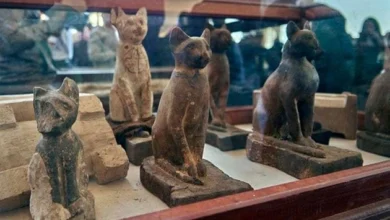The legends of Lamia and Empusa

There are many legends about lamias, strange creatures of darkness but did they ever exist, or is it just a figment of the imagination of people who were afraid of the night? The first mention of Lamia appeared in Greek mythology.
According to legend, she was once the queen of Libya, a beautiful woman who had children by Zeus. But when Hera, the wife of the thunderer, found out about this, she ordered the queen to devour the babies. Lamia had to obey because it is difficult to argue with the gods. In addition, Hera, out of jealousy, deprived the queen of sleep.
As a result, hiding in a gloomy dungeon, she turns into a real monster that feeds on people. Unable to sleep, she wandered at night and sucked the blood of people she met, and her victims were most often young men.
Before sucking the blood, she tore them apart with her claw-like nails. To fall asleep, Lamia took out her eyes, becoming the most vulnerable at this time.
Being half a woman, half a snake, the queen gave birth to a creepy offspring called “Lamia”. Creatures have polymorphic abilities and can act in various guises, usually as beastman hybrids. However, more often, they are likened to beautiful girls because it is easier to attract frivolous men. Lamias sucked blood from their victims and attacked unarmed and sleeping people, depriving them of vitality.

According to another legend, the name Lamia was originally worn by a mythical queen known for her beauty and cruelty. For her wildness, the gods turned her into a monster with the body of a snake and a woman’s head.
The name has become a household name, therefore, among ancient writers, we already see an appeal to lamias exclusively in the plural – they have become an ancient Greek allegory of envy. These are creatures like sirens, living together with dragons in caves and deserts. Their attribute is a golden comb, with which they comb their lush hair.
There is another legend. The English clergyman, writer, and scientist of the XVII century Robert Burton cited the story of the ancient Greek sophist Philostratus in his book “On the Life of Apollonius”: “A certain Menippe the Face, a young man, on the way between the Canchrei and Corinth met a similar ghostly creature in the guise of a beautiful young woman.”
Taking him by the hand, she led the young man to her house on the outskirts of Corinth. There she said that she was a Phoenician by birth, and if Menippe lived with her, he would hear how she sang and played, how she treated him with sweet wine, and most importantly, she would serve him faithfully until the end of her life. Actually, Likiy was a philosopher, lived sedately, and modestly, and knew how to restrain his passions. However, he could not resist the passion for love. The young man lived with this woman for quite a long time with great pleasure and finally married her.
“Among other guests, Apollo himself came to the wedding, who discovered that this woman was a snake, a lamia, and that all her possessions and wealth were illusory. When the woman saw that she had been exposed, she began to cry and asked Apollo to be silent, but it did not touch him at all. At the same moment, she, the silverware, the house, and everything in it disappeared.”
The name “lamia” is etymologically derived from the word used in Assyria and Babylon to call demons who kill infants. According to ancient authors, lamias are creatures like sirens and inhabit the deserts of Africa. Above the waist, they have the shape of a beautiful woman, while the lower half is serpentine. Some called them witches, others — evil monsters that lure travelers into the desert and devour them.
Lamia originally lived in Africa but eventually settled all over the world. They settled in caves, forests, ravines, if they were lucky, in old abandoned castles; they went out for a walk, like any self-respecting evil force, at night.
The image of Lamia can be considered as a symbol of vicious passion and the illusory nature of material goods. But, according to some legends, Lamia is easy to expose: it is enough to force her to cast a vote. Since lamias have a forked tongue, they are deprived of the ability to speak, they can only whistle melodiously.
In eastern Europe, Lamia was associated with the nightmare of mara — a spirit in the form of a tall woman or, on the contrary, a hunched old woman, but almost always with long loose hair. Among the southern Slavs, Lamia is a monster with the body of a snake and a dog’s head: it descends like a dark cloud on fields and gardens, devouring the fruits of agricultural labor.
However, no matter how strong the belief in these monsters was, as the centuries passed, people lost their fear of Lamia. Already in ancient times, it served simply as a means of intimidating parents of disobedient children. Nevertheless, the echoes of these beliefs are still alive today: if a child suddenly dies, they say that he was strangled by Lamia.
Today lamias are not widespread because the Inquisition and activists — vampire hunters — at one time exterminated them everywhere: silver bullets, holy water, and aspen stakes were used. For some time, they disappeared altogether, but in the 18th century, these creatures reappeared in England, France, Greece, Italy, and Spain.
The magicians of that time could not stop their reproduction in time, and as a result, today, as mystics say, we have more than one thousand lamias all over the world.
In 1577, Johann Vier’s treatise “The Life of Lamias” appeared. It notes that the main and undoubted attribute of these vampires is a golden comb. Lamia has the ability to change her appearance, turning from a half-snake into a woman of incomparable beauty.
However, this transformation is not complete. The tongue remains forked like a snake, and the voice hisses and whistles. That is why lamias never speak in full voice, preferring a dramatic whisper. In addition, they do not have a permanent appearance, they change their age, figure, skin, and hair color. That is why it is very difficult to recognize a lamia once seen later.
Lamias are also called vampires, who, according to the popular idea of the late Greeks, under the guise of beautiful maidens, attract young men and suck their blood.
The word “lamia” was used in the Latin translation of the Holy Scriptures as a designation of the Hebrew name Lilith. The word has numerous associations in folklore and legends. In the writings of demonologists, Lamia symbolized a nightmare. Lamias were also called creatures like sirens or nereids.
A close relative of lamia — empusa. In Greek myth-making, it is a demonic creature with donkey legs, a monster that sucks the blood of a sleeping person at night.
Empusa was considered a night spirit and belonged to the so-called Mormolics – creatures from the retinue of the goddess of witchcraft and magic, Hecate. The goddess sent Empusa, who took various images, to frighten people, mainly women, and children.
The demoness could look like a dog, a cow, a donkey, a terrible ghost with a flaming face or like a beautiful maiden. Besides, she liked to frighten travelers. However, she could easily be scared off with an abusive word, hearing which, the Empusa, screeching, turned to flight.
According to existing beliefs, she often carried away small children, and because of belonging to the Mormons, beings who did not know the pleasures of love, she sucked the blood of young men, appearing to them in the image of a charming woman. Empusa was related to Erinia and Eumenides, who received not only widespread but also a very persistent cult.
Empusa is mentioned in the comedies of Aristophanes but in a slightly different way. According to the great comedian, this is a monster in Hades, which is a dog with one leg of copper, and the other of manure.
Thus, it can be concluded that Empusa is an inhabitant of the underworld, who can change her appearance, but has well-established attributes a bronze leg and a flaming face. If in the episode of “Frogs” Aristophanes Empusa appears as a monster, one of the inhabitants of Hades, then in the second episode we see her already as a beautiful seductress.
In both cases, she is a terrifying and certainly dangerous creature. The very mention of her in dramatic works testifies to the widespread prevalence of legends about her since theatrical productions were designed for the masses and, accordingly, their realities had to appeal to the traditional, widespread, “knowledge shared by society”.
This is evidenced by the mention of Empusa by Demosthenes in his “Speeches”, which were also pronounced with a large crowd of people. A variety of protective amulets, and precious stones, which were believed to have various miraculous properties, were widely used against such malicious creatures.
The author of the II century, Dionysius mentions that jasper is terrible for Empusa: “The sea represents a lot of wonderful things for people, and also produces crystal and dark jasper, scary for Empusa and other ghosts.”
Another mention of it belongs to the author of the III century Flavius Philostratus, and his story is clearly folklore in nature. This story was later used by Jan Potocki in the “Manuscript Found in Zaragoza”.
Here is how Philostratus wrote: “Go into what I have said! This affectionate bride is one of the Empusa, whom many believe to be ghouls and werewolves. They both fall in love, and are committed to lust, and even more, they love human meat – that’s why they lure those whom they want to devour into the lustful nets.”
Here the image of Empusa expands, making her connection with Lamia clear. The often mentioned relationship of Empusa with Hecate has its roots not in antiquity, but in the Byzantine dictionary of the 10th century called “Svida”. There, this creature is a demonic ghost sent by Hecate to people, or she herself.
“Svida” mentions two more names of Empusa, the first is Oinople, since she appears out of the darkness and is endowed with the ability to change her appearance. Another name is Onoskelis (“with donkey legs”). The latter creation is often considered an independent demon found in the Testament of Solomon, a Jewish monument written in Greek.
There Onoskelis is described as an attractive woman with donkey legs, that is, outwardly she is nothing but a female satyr.




